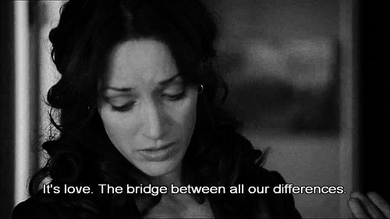December 6, 2014 - 12:23

For my intersectionality essay, I’d like to do a close reading of a couple episodes of The L Word, in order to look at how the character of Bette grapples with her many, complicated identities—and, in turn, how the media represents intersectional characters. Bette is a very proud and vocal lesbian, as well as a biracial (often white-passing), upper-class, able-bodied individual. The relationship between these identities really come into play when she and her partner, Tina (who is white), decide to have a child. The couple argue over whether or not it makes sense to use an African-American donor, if Tina is carrying the child (Bette argues that it is, because that way, the baby would look like both of them). This process is interesting from an intersectional standpoint because it is related not only to race, but also to the disability-studies-related process of “engineering” the perfect baby (and reminds me of the article circulating the internet of the white lesbian couple who become upset when they find that their baby must have come from a sperm donor of color). Tina argues that she is unfit to raise a mixed-race child, and that it is “a whole lot of otherness” to place on a baby who will already be a child of lesbian mothers.
Bette and Tina attend group therapy, where they meet another woman, Yolanda, who strongly identifies as African-American. She calls Bette out for failing to claim her race, while Bette counters with the point that she is not just African-American, she is African-American and white. Yolanda claims that Bette and Tina should not have a mixed-race child until Bette is ready to claim her race. The storyline is complicated when Bette and Tina discover that Yolanda is, in fact, a lesbian as well—but she has not been vocal about her sexuality, just as Bette has not been vocal about her race. Here, we have the opportunity to see how the passing privilege Bette has (along with her upper-class status) allow her to vocally embrace her non-normative sexual orientation, which is not so much the case for the darker-skinned Yolanda.
A close reading of this storyline, by itself, would likely fill 5 pages. However, I’m also really interested in discussing Bette’s relationship to the token transgender, lower-class, and disabled characters who come into the show later on in the series. When Max joins the show, initially presenting as a very masculine-of-center lesbian (who later comes out as transgender), he comes from a working class background. Bette and her friends are not very understanding of Max’s position, and comment negatively on his clothing (in part because it is not as expensive or as “nice” as their own, and in part because it is the least feminine attire we see on the show (even Shane, the androgynous heartthrob, wears very gender-neutral clothing compared to Max’s masculine style). Despite her own non-normative identities, Bette is too privileged by her class and passing privilege to manage to empathize with Max’s struggle. Max has struggled in ways that Bette simply has not.
Later on in the series, Bette begins a relationship with a deaf artist named Jodi Lerner. It is interesting to contrast this relationship with the one Bette forms (or, rather, fails to form) with Max, because it becomes clear that despite their differences in communication, Bette bonds fairly easily with Jodi. Like Bette, Jodi is an upper-class, white-passing artist who works for a university. Their similar social status (at least in the environment they inhabit) is enough for Jodi’s disability to not hinder their relationship, for the most part, and Bette’s attempts to learn sign language are exhibited as playful and only slightly frustrating.
This topic would easily draw in notions of horizontal and vertical identities, and complicate them through the storyline of Bette and Tina’s reproduction. Here, horizontal and vertical identities are not so simply named, because their desire to have a mixed-race child is not truly passed on genetically, though it is something they would, technically, share if they could reproduce biologically. Bette’s relationships with Yolanda, Max, and Jodi are all examples of contact zones that I would explore through this paper.
Stepping back from a close reading, looking at The L Word would be a very straightforward way of observing the ethics of representation (especially as it relates to intersectional characters, and “token” disabled, trans, and working-class characters). Additionally, The L Word as a form of mainstream media caters directly to capitalism, and would be an interesting way of looking at feminist economics.
SO: The bottom line is, I need to pare this down quite a bit (I just realized this is almost the length of the actual paper…). Over the next week, I’ll focus in more on some aspect of Bette’s character and start writing! Here's a picture of Bette dramatically pondering everyone's differences:


Comments
YES YES YESSSSSS
Submitted by khinchey on December 7, 2014 - 21:51 Permalink
YES YES YESSSSSS